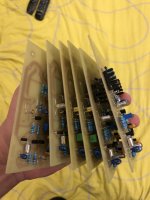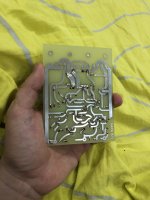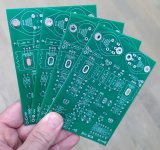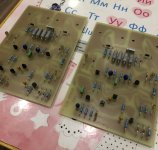what would be the best purchase solution for a pair of MJ15003G?
Onsemi or Motorola? Tell me yours
Onsemi or Motorola? Tell me yours
The problem with MJ15003, 2N3055, 2N3773 etc. is they are not fast enough at switching a quasi-complementary output stage. They will "work" but just don't sound right or good enough, not at least up to Naim sound quality. Naim's early models all used power switching type transistors for that sound quality reason. Later, they changed to Sanken LAPTs which were even better and remain as preferred audio types everywhere, even today. Unfortunately, you can't buy these in a TO220 package to suit old Nait models any more but you can still use power switching type BD911 as a good substitute. Note that this means you can otherwise use any of the modern, ring emitter type audio semis, including cheap and cheerful 2SC5200, TTC5200 etc. However, when you make such radical changes to transistor types, always check stability with an oscilloscope - listening with your ears usually tells you nothing about what will happen when you turn up the volume for a party in warm weather 🔥
Last edited:
I asked the same question in the other thread, see here, because someone said something similar about switching speed, but I don't get it:
So can you please explain why the switching speed is important for this kind of output stage? I thought it doesn't really switch (unlike a digital power amp), so it's not clear to me why it needs to be able to switch >7MHz...
So can you please explain why the switching speed is important for this kind of output stage? I thought it doesn't really switch (unlike a digital power amp), so it's not clear to me why it needs to be able to switch >7MHz...
These certainly aren't class D tech. but class AB amplifiers like Naim output stages, do switch power transistor duties from +ve to -ve potentials of a sine wave for example, following the voltage amp. and driver output potential, as it crosses over between them. Whilst the amplifier's output closely follows the class A voltage amp, there is always a discontinuity of some proportion. So we add a bias voltage to the transistor emitter potentials that can null a fixed bias error but it will never be perfect due to a significant thermal tracking problem. In other words, the remaining distortion will probably still be noticeable at a low peak levels and that's unfortunately where do most of our critical listening.
Nothing is as perfect as the sales blurb makes out - it's just close enough to fool the average guy
Nothing is as perfect as the sales blurb makes out - it's just close enough to fool the average guy

I should add that there are plenty of tutorials on class AB amplifiers. They are often over-simplified and brief to the point of incomprehensible but the important point is that the output is the sum - the combined +ve and -ve swings (with respect to 0V) of the audio output waveform. Like class B, it is produced i.e. switched on alternately in what is also known as a push-pull arrangement, by the upper and lower output power transistors. Be aware though, that class AB incorporates the bias and improved linearity that class B does not.
e.g. https://www.electronics-tutorials.ws/amplifier/class-ab-amplifier.html
e.g. https://www.electronics-tutorials.ws/amplifier/class-ab-amplifier.html
Last edited:
I think it's a case of mixing up correlation with causation.can you please explain why the switching speed is important for this kind of output stage? I thought it doesn't really switch (unlike a digital power amp), so it's not clear to me why it needs to be able to switch >7MHz...
Linear amps at audio frequencies don't "switch". By definition.
Some characteristics of transistors that are designed for switch mode, such as low capacitance, are favourable for linear mode.
Conversely, a device that is unfavorable for switch mode might be favorable for linear mode.
Note too that a device optimized for switching may be unfavorable for linear mode, for example, it may be too non-linear or may not have enough capacitance for stability.
Naim amps were single, feedback loop designs. I say "were" because I'm years out of touch now and the Statement was a departure by having separate feedback loops for input and output stages (I think because they couldn't get the monster to work otherwise).
Feedback designs trade bandwidth for accuracy. This creates a need for a fast output stage which needs faster power transistors. By faster I mean, principally but not exclusively, lower electrical inertia.
You will follow the logic that a switch mode transistor is designed for low power loss and low drive energy, and this requires lower capacitance, among other things. Power dissipation capability is traded for switching efficiency, and linearity is irrelevant.
The art of audio is to know what characteristics you want and to choose the best devices regardless of what commercial application they are optimized for.
Feedback designs trade bandwidth for accuracy. This creates a need for a fast output stage which needs faster power transistors. By faster I mean, principally but not exclusively, lower electrical inertia.
You will follow the logic that a switch mode transistor is designed for low power loss and low drive energy, and this requires lower capacitance, among other things. Power dissipation capability is traded for switching efficiency, and linearity is irrelevant.
The art of audio is to know what characteristics you want and to choose the best devices regardless of what commercial application they are optimized for.
Hi traderbam,
Don't you mean loop gain fpor accuracy? The power bandwidth is unaffected unless you roll it off on purpose and that is for stability (phase margin) reasons.
-Chris
Don't you mean loop gain fpor accuracy? The power bandwidth is unaffected unless you roll it off on purpose and that is for stability (phase margin) reasons.
-Chris
Yes. I should have written "use bandwith for accuracy". Maybe both in the sense that there is no point having any closed loop gain above 20kHz, so excess bandwidth can be traded for accuracy. But you are right that it's the (stable) excess loop gain that does the work.
lol!
Given that we don't have infinite slope filters, I guess we are stuck with excessive bandwidth beyond 20 KHz. Just having fun.
The problem with being in the industry is that we often don't express ourselves completely since our meaning is understood to others in the industry. However here we have many folks who aren't electrical / electronic engineers and don't understand the lingo and concepts fully. I try to keep that in mind, but often fall into the same trap.
-Chris
Given that we don't have infinite slope filters, I guess we are stuck with excessive bandwidth beyond 20 KHz. Just having fun.
The problem with being in the industry is that we often don't express ourselves completely since our meaning is understood to others in the industry. However here we have many folks who aren't electrical / electronic engineers and don't understand the lingo and concepts fully. I try to keep that in mind, but often fall into the same trap.
-Chris
Audio electronics at DIY level isn't a secret art and making the occasional, proper reference to widely available electronics texts wouldn't hurt to explain theory or our points of view here. I realise that may not be simple when you're working from memory or out-of-print texts but keeping up to date and referring to popular, detailed and affordable works such as "Horowitz and Hill" would make communication and understanding easier. OK, I'm assuming that at least some pros are happy and prepared to do that but this is DIY territory, after all.
Old boards of NAP110/250 CB diy
this video need watching with switch on CC English translator. Sorry
this video need watching with switch on CC English translator. Sorry
Last edited:
Step by step
Selected of the every part nominals and soldering to board.
Hand made DIY old NAPs
Second stage searching and buy the BDY56 or NA002 transistors
P.s if your Naim NAP board is burn
You Have more chances to recover it with new board
Selected of the every part nominals and soldering to board.
Hand made DIY old NAPs
Second stage searching and buy the BDY56 or NA002 transistors
P.s if your Naim NAP board is burn
You Have more chances to recover it with new board
Attachments
- Home
- Amplifiers
- Solid State
- NAIM Audio NAP 110 restoration



